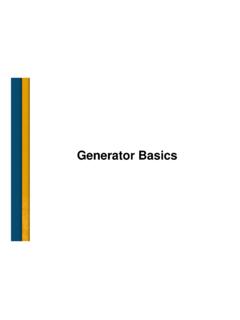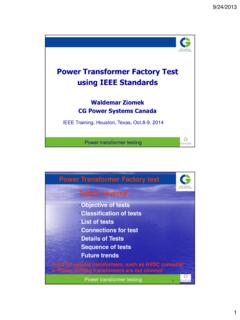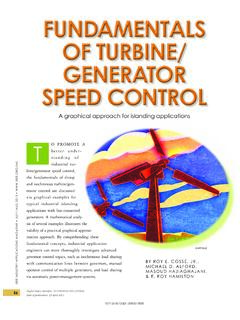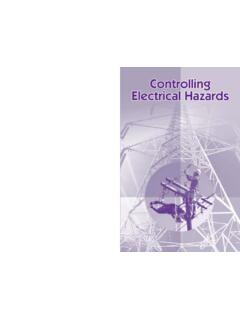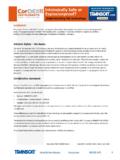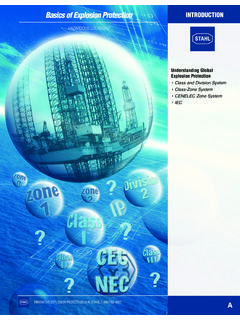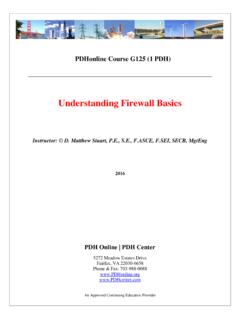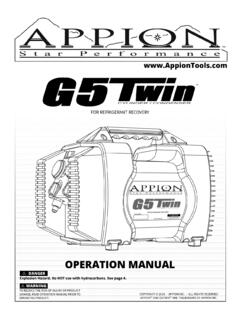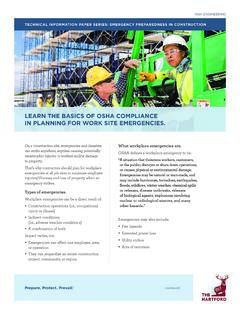Transcription of Electrical Area Classifications - IEEE Region 5
1 Electrical Area Classification 101An Introduction to Area Classification the BasicsOctober 3rd, 2017 IEEE Houston CEDV incent W. Wedelich, PE, MBA Project Manager Associate Electrical Engineer 10 Years Consulting at BMcD 16+ years in manufacturing EAC Projects, Refineries, Chemical Facilities, Designing Skids Topic Active ShooterLast resort is to fight. Introduction to area classification terminology and standards. Identifying Electrical equipment that can be used in different hazardous areas. Introduction to PIP ELEHA01 Specification Introduction to PIP ELEHA01 Form No. 1 Flammable Combustible.
2 Introduction to PIP ELEHA01 Form No. 2 Sources of will be covered in this WE TYPICALLY USE IN THE USA: API-500, NFPA 70, NFPA 496, NFPA 4976 HISTORY OFSTANDARDS Originally published in 1955 American Petroleum Institute (API) Recommended Practice 500A concerns the classification of locations for Electrical installations in petroleum refineries. It is a very widely used and respected document, though rather conservative in the application of distances. Originally published in 1961 API Recommended Practice 500B deals with the classification of areas for Electrical installations at drilling rigs and production facilities on land and on marine platforms.
3 It is a widely used and respected document, very useful for platform design. It may be ready for some updating and conflicts with API RP500A and C with regard to aspects of artificial ventilation. It is less conservative when applying distances than API RP500 A and C. Originally published in 1966 API Recommended Practice 500C outlines the classification of locations for Electrical installations at pipeline transportation facilities. It is a widely used and respected document, recently updated, and introduces pressure levels. (Current third edition 2012 API-500 it includes the 3 above A,B,C in one document)7 HISTORY OFSTANDARDS National Fire protection Association (NFPA) 497 concerns the classification of Class I hazardous locations for Electrical installations in chemical plants.
4 Currently undergoing extensive revision, this standard is to be replaced by NFPA 497A, Recommended Practice for the Classification of Class I Hazardous (Classified) Location for the Proper Installation of Electrical Equipment in Chemical Process Areas. NFPA 497 is a very useful document to be used in conjunction with API Recommended Practices; however, it appears to be conflicting in several instances. NFPA 497 (we are currently at 2017 edition) NFPA 497M is a manual for the classification of gases, vapors, and dusts for Electrical equipment in hazardous locations. It is a new document, extremely useful as a supplement to Underwriters' Laboratories (UL) for determining gas groups.
5 In the National Electrical Code NFPA 70, articles 500, 501, tables 514-1, 515-2, and article 516 are essential for the satisfactory selection of Electrical equipment and installation techniques for classified areas and cover specific details on area classification for gasoline dispensing and service stations, bulk storage plants, spray application, and dipping and coating NFPA 321 outlines the basic classification of flammable and combustible liquids. It subdivides flammable and combustible liquids into classes. NFPA 325M describes the fire hazard properties of flammable liquids, gases, and volatile solids.
6 This guide can help determine gas groups not specified in NFPA 497M or elsewhere. Originally created in 1966; NFPA 496 deals with purged and pressurized enclosures for Electrical equipment in hazardous locations. (we are currently at 2013 edition) Instrument Society of America (ISA) covers the same subject. NFPA 496 is currently being reviewed to cover situations where a source of flammable vapor exists within the purged enclosure. In NFPA 493 intrinsically safe apparatus and associated apparatus for use in Class 1, 2, 3, Division I hazardous locations are discussed. This standard is currently being reviewed for replacement by a new document which is intended to be prepared by a UL Technical Group.
7 NFPA 30 on flammable and combustible liquids covers the subject of ventilation, handling, and storage of flammable and combustible liquids. Before going to the step-by-step method for performing Electrical area classification, it should be explained that a classified (hazardous) area is defined by three parameters; these being 1) class, 2) group, and 3) division. For example, an area containing gasoline could be classified Class I, Group D, Division 1, and these three parameters will define its classification. We will go into further detail on these three parameters later in this first step in area classification is to establish the relevant codes and standards and the authority having jurisdiction, and any permit or other licensing-type of the larger US operating companies now have standards of their own, and these should be studied as a first step, followed by the other codes and standards dictated by the relevant authority.
8 At this point, a mention should be made to define the phrase "authority having jurisdiction." The NFPA defines this as follows. The authority having jurisdiction is the organization, office, or individual responsible for approving equipment, an installation, or a procedure. Area classification drawings are used to help create a hot work map, which is used as a reference when completing hot work permits. Through management support, an extensive training and awareness program, and adjustments to the hot work permitting process, it is anticipated that workers will have greater awareness and respect for fire and explosion hazards associated with flammable fluids at operating facilities.
9 This represents a new advance in application of the area classification methodology to not only protect workers through safe Electrical designs, but also to increase the effectiveness of the hot work permitting drawings are used for a wide variety of purposes. ANSI Methodology to Hazardous Area Classification There are two major philosophies used when developing HAC drawings and details per ANSI standards, and a third approach found in international standards. The first ANSI approach is The Direct Example Approach. The direct example approach is the most commonly used method to develop hazardous area classification plans and details, and is usually the most conservative approach.
10 The diagrams found in API RP 500, API RP 505 and NFPA 497 are examples of the direct example approach method. This approach utilizes engineering judgment to determine the extent of the hazardous area classification. The diagrams and the boundary distances utilized are selected based on the type of installation, volume and properties of the hazardous gases/vapors. The second ANSI method, less commonly used, but usually less conservative, is the Point Source Approach. The point source approach determines the hazardous classified boundaries for each potential release source of flammable gases/vapors.


